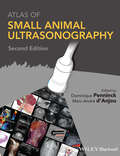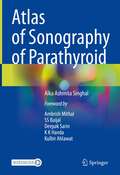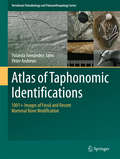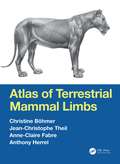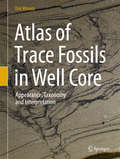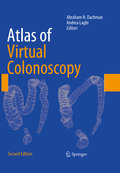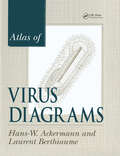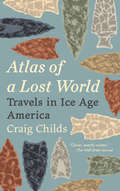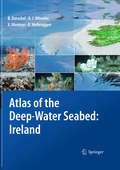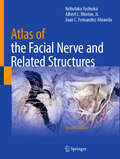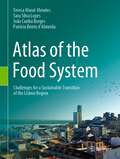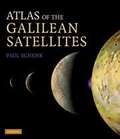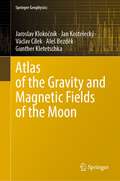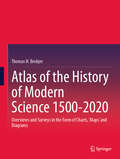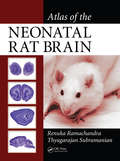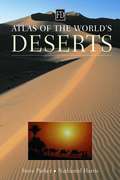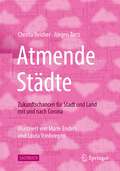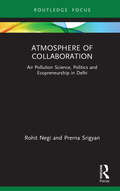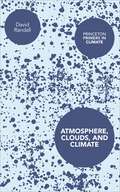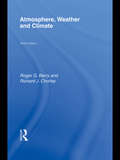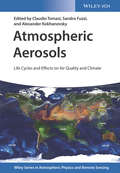- Table View
- List View
Atlas of Small Animal Ultrasonography
by Dominique Penninck Marc-André D'AnjouAtlas of Small Animal Ultrasonography provides a highly visual guide to the use of diagnostic ultrasound in small animal practice. This up-to-date atlas of the most commonly performed ultrasound examinations will be a valuable reference to well-established users of ultrasound as well as those just being introduced to the technology.Each chapter provides the reader with valuable information on the use of ultrasound diagnostics in small animal veterinary medicine. Taking a systems-based approach, Atlas of Small Animal Ultrasonography is divided into chapters on ultrasound procedures and techniques for examination of all major body parts and systems. Each chapter provides numerous illustrations and ultrasound images to aid the reader in diagnostic interpretation.Atlas of Small Animal Ultrasonography is an in-depth reference that provides thorough coverage of ultrasound techniques and interpretation. This volume will serve as an indispensable guide to the use of this important clinical modality.
Atlas of Sonography of Parathyroid
by Alka Ashmita SinghalThis comprehensive atlas covers various common and uncommon cases of parathyroid disorders encountered in the day to day radiological practice. It serves as an illustrative database with numerous state of the art images of the diverse imaging features of parathyroid nodules and their correlation with various other imaging modalities. The book includes videos as well. It covers the typical and atypical ultrasound features of parathyroid nodules, their color Doppler findings and Sestamibi correlation. Size of the nodules detected range from small sub-centimeter nodules measuring between 6-15 mm, where often the sestamibi scan is negative, and diagnostic ultrasound scan is quite vital in management of these cases. The larger nodules range in size to be even larger than the thyroid gland and completely compressing and displacing the thyroid gland, which often leads to a missed diagnosis on initial imaging.Chapters cover tips and tricks in scanning along with various pitfalls. Additionally, it covers parathyroid nodules diagnosed on ultrasound in Sestamibi negative cases, localization of additional parathyroid nodules and parathyroid carcinoma. It covers correlation with surgical findings and includes histopathology images where relevant. The book serves as a teaching tool for radiologists, ENT surgeons, head and neck surgeons, general surgeons, endocrinologists, nephrologists, gastroenterologists, medical oncologists and radiation oncologists involved in the management of parathyroid disorders.
Atlas of Taphonomic Identifications: 1001+ Images of Fossil and Recent Mammal Bone Modification (Vertebrate Paleobiology and Paleoanthropology #0)
by Peter Andrews Yolanda Fernández-JalvoThe aim of the atlas is to provide images of taphonomic modifications, making it as comprehensive as possible with evidence presently available. This volume is intended both as a field guide for identifying taphonomic modifications in the field, and for use in the laboratory when collections of fossils are being analyzed. Images in the book are a combination of scanning electron micrographs, regular photographs, cross-sections of bones and line drawings and graphs. By providing good quality illustrations of taphonomic modifications, with links between similar types of modification, the atlas provides a reference source for identifying the agents responsible for the modifications, the processes by which they were formed, and the potential bias introduced by the processes. The authors also aim to emphasize on the directions they consider taphonomic studies should be headed. Firstly, we should seek to quantify the degree of bias introduced into a fossil fauna and to take account of this bias before interpreting the palaeoecology of the fossil site. Secondly, we should recognize that taphonomic modifications increase the information encoded in fossils by identifying perimortem and postmortem context s. This provides a more dynamic and realistic view of the past.
Atlas of Terrestrial Mammal Limbs
by Anthony Herrel Christine Böhmer Jean-Christophe Theil Anne-Claire FabreAtlas of Terrestrial Mammal Limbs is the first comprehensive and detailed anatomy book on a broad phylogenetic and ecological range of mammals. This extraordinary new work features more than 400 photographs and illustrations visualizing the limb musculature of 28 different species. Standardized views of the dissected bodies and concise text descriptions make it easy to compare the anatomy across different taxa. It provides tables of nomenclature and comparative muscle maps (schematic drawings on the origins and insertions of the muscles onto bones) in a diversity of animals. Atlas of Terrestrial Mammal Limbs is a reliable reference and an indispensable volume for all students and professional researchers in biology, paleontology, and veterinary medicine. Key Features: Provides an overview of the anatomy of the mammalian limb Includes osteological correlates of the limb muscles Illustrates anatomy in 2D Guides dissection Documents anatomical diversity in mammalian limbs Related Titles: D. L. France. Human and Nonhuman Bone Identification: A Color Atlas. (ISBN 978-1-4200-6286-1) S. N. Byers. Forensic Anthropology Laboratory Manual, 4th Edition (ISBN 978-1-1386-9073-8) S. N. Byers. Introduction to Forensic Anthropology, 5th Edition (ISBN 978-1-1381-8884-6) R. Diogo, et al. Muscles of Chordates: Development, Homologies, and Evolution (ISBN 978-1-1385-7116-7)
Atlas of Trace Fossils in Well Core: Appearance, Taxonomy and Interpretation
by Dirk KnaustThis book provides the reader with a well-balanced blend of high-quality photographs, figures and accompanied text for the identification of trace fossils both in core and in outcrop. Ichnological data become more and more crucial in sedimentological and paleoenvironmental interpretations, not only in the exploration and exploitation of hydrocarbons but also in the characterization of aquifers and in scientific drilling. After an introduction to the study of trace fossils in core and an outlining of ichnological basics, principles and concepts, the book continues with a detailed description and interpretation of 39 trace fossils (ichnogenera) and associated features (such as bioturbate texture, plant roots and their traces, borings and pseudo-trace fossils) commonly encountered in well cores and in outcrop. The trace fossils are highlighted by their expression in well core, nicely illustrated with carefully prepared eye-catching core photographs. This unique information is complemented with examples of trace fossils in outcrop, as well as relevant key figures from the literature. Each description is presented in a consistent manner, stating the ichnogenus name and author in the title, followed by sections about morphology and size, ichnotaxonomy, substrate, appearance in core, similar trace fossils, producers, ethology, depositional environment, ichnofacies, age as well as reservoir quality. The book is rounded off with an extensive list of references for further reading. The material for the book originates from the author's continuous work with trace fossils in core over the last two decades.
Atlas of Virtual Colonoscopy: Comprehensive Atlas And Fundamentals
by Abraham H. Dachman Andrea LaghiAtlas of Virtual Colonoscopy thoroughly revises and updates Abraham Dachman's bestselling first edition. Joined in this edition by co-editor Andrea Laghi, Dr. Dachman has expanded the focus of the text to cover fundamental topics of this rapidly evolving technology, including the history of virtual colonoscopy, a review of clinical trial data from throughout the world, and a presentation of clinical background information. Also included are chapters covering patient preparation and tagging, performing and reporting virtual colonoscopy, viewing methods, MR colonography, and computer aided detection. The second part of the text presents an atlas of high-resolution images with detailed explanations of teaching points, covering normal anatomy; sessile, pedunculated, diminutive and flat lesions; masses; stool and diverticula; and common pitfalls. Atlas of Virtual Colonoscopy is a valuable resource for all radiologists and gastroenterologists interested in learning the fundamentals of this exciting technique.
Atlas of Virus Diagrams
by Hans-Wolfgang Ackermann Laurent BerthiaumeAuthored by electron microscopists and leading members of the International Committee on Taxonomy of Viruses (ICTV), the Atlas of Virus Diagrams includes chapters on virus classification. The diagrams, selected for content and historic and aesthetic value, illustrate vertebrate, invertebrate, and plant bacterial viruses taken from English, French, and German language virological literature. The book presents this information in three sections: Overviews, including vertebrate and plant virusesViruses with cubic and helical symmetryViruses with binary symmetry (tailed bacteriophages).
Atlas of Weed Mapping
by Hansjoerg KraehmerWeeds are variously defined as plants growing where they are not wanted, plants that interfere with human activity. Weeds affect everyone in the world by reducing crop yield and quality, delaying or interfering with harvesting, interfering with animal feeding, reducing animal health, preventing water flow, as plant parasites, etc. It is estimated that those problems cause $ billions worth of crop losses annually and the global cost of controlling weeds also runs into many $ billions every year. Atlas of Weed Mapping presents an introductory overview on the occurrence of the most common weeds of the world. The book notably includes: Description of cropping practices and explanations for the global distribution of weeds Invasive plant mapping Aquatics and wetland plants with histological plant details Theoretical and practical aspects of weed mapping Aspects on the documentation of herbicide resistance Biodiversity, rare weeds and the dominance of the most common weeds Fully illustrated with more than 800 coloured figures and a number of tables, this new characterisation of anthropogenic vegetation will be interesting for readers of a great number of disciplines such as agriculture, botany, ecology, geobotany and plant community research. More than a hundred experts have contributed data to this unique compilation.
Atlas of a Lost World: Travels in Ice Age America
by Craig ChildsFrom the author of Apocalyptic Planet comes a vivid travelogue through prehistory, that traces the arrival of the first people in North America at least twenty thousand years ago and the artifacts that tell of their lives and fates.In Atlas of a Lost World, Craig Childs upends our notions of where these people came from and who they were. How they got here, persevered, and ultimately thrived is a story that resonates from the Pleistocene to our modern era. The lower sea levels of the Ice Age exposed a vast land bridge between Asia and North America, but the land bridge was not the only way across. Different people arrived from different directions, and not all at the same time.The first explorers of the New World were few, their encampments fleeting. The continent they reached had no people but was inhabited by megafauna—mastodons, giant bears, mammoths, saber-toothed cats, five-hundred-pound panthers, enormous bison, and sloths that stood one story tall. The first people were hunters—Paleolithic spear points are still encrusted with the proteins of their prey—but they were wildly outnumbered and many would themselves have been prey to the much larger animals.Atlas of a Lost World chronicles the last millennia of the Ice Age, the violent oscillations and retreat of glaciers, the clues and traces that document the first encounters of early humans, and the animals whose presence governed the humans’ chances for survival. A blend of science and personal narrative reveals how much has changed since the time of mammoth hunters, and how little. Across unexplored landscapes yet to be peopled, readers will see the Ice Age, and their own age, in a whole new light.
Atlas of the Deep-Water Seabed: Ireland
by Andrew J. Wheeler Boris Dorschel Koen Verbruggen Xavier MonteysPresented in an accessible, user-friendly format, this atlas sets out all the major features revealed during one of the largest ever deep-sea mapping campaigns. A unique insight into the morphology of the seabed along the continental margin of the North-East Atlantic, it reveals for the first time many features that have hitherto been hidden beneath the waves. It is organised both thematically and by region, with the sea floor and its biological hotspots - areas of high biodiversity such as seamounts - shown at a resolution not possible before. The atlas presents everything from submarine canyons to coral carbonate mounds, using digital terrain models generated from multibeam data and photographs taken from unmanned deep-water vehicles (ROVs). The full-colour imagery includes digital three-dimensional seabed maps as well as the photographs, with concise text descriptions and topic boxes used to highlight and explain the geological, biological and hydrographical features, in addition to their importance and context in the deep-sea realm. Alongside the wealth of background information and topic boxes on special highlights, extensive on-line resources link the reader to full data sets and GIS locations, while suggestions for further reading point to ongoing research highlights. This is a fascinating resource that will be of use to anyone involved in off-shore and underwater activities, whether scientific or commercial.
Atlas of the Facial Nerve and Related Structures
by Nobutaka Yoshioka Albert L. Rhoton, Jr. Juan C. Fernandez-MirandaThe second edition of the esteemed atlas provides an in-depth exploration of craniofacial anatomy, enhanced by images of real cadavers that vividly depict the details of human anatomy. Updated content includes a detailed examination of the intratemporal facial nerve, the extraparotid peripheral branches, and their innervation of the mimetic muscles. Delving into the nuances of the intracranial region, skull anatomy, and the complexities of the upper and lower facial regions, this edition captures every detail with stunning clarity. Organized by region for comprehensive learning, each dissection reveals an intricate network of nerves and structures with accuracy. Supported by precise clinical explanations, the book offers profound insights into neurosurgical-related pathologies and beyond. From mimetic muscle myectomy and neurectomy to nerve transfer for facial paralysis, readers will find the knowledge within these pages indispensable for performing precise and safe procedures on the face. Beneficial across various medical specialties including plastic surgery, otolaryngology, neurosurgery, and craniofacial surgery, this atlas is essential for physicians seeking a comprehensive understanding of craniofacial anatomy. Physiotherapists and practitioners of chemodenervation therapy will also discover invaluable insights within this volume.
Atlas of the Food System: Challenges for a Sustainable Transition of the Lisbon Region
by Teresa Marat-Mendes Sara Silva Lopes João Cunha Borges Patrícia Bento d'AlmeidaThis book is a visual guide to the territorial dynamics operating within a territory. The reading of such dynamics is fundamental in understanding the role of food in cities. This atlas provides a refreshing approach to the study of the city and of its territory, expanded from the perspective of the food system. This book illustrates the impacts of urban planning options on the function of the contemporary Food System of the Lisbon Region, while disclosing its associated urban form solutions. It provides a possible methodology for the reading of the food system based on an analysis of planning instruments and their morphological outcomes, both in the territory but also on the various built forms which have resulted over time. A key focus of the atlas is exploring how planning has regulated the evolution of the Lisbon Region since the 20th century and its implications on the food system. The atlas results from an exhaustive survey and research work conducted in Lisbon Metropolitan Area for a research project, SPLACH – Spatial Planning for Change, for the past 3 years, in terms of the analysis of its Food System and Urban Planning, aiming to inform the delineation of planning strategies towards a sustainable urban environment. It is an important reference for planners, architects, planning and architecture students as well as municipal technicians and the general public, as it provides a refreshing and useful source of information to support further readings about the food system and its relations to urban planning instruments and urban form solutions. Furthermore, it builds a contemporary reading about possible solutions to promote a sustainable transition of the current food systems, while enhancing the strategic role of planning and urban form.
Atlas of the Galilean Satellites
by Paul SchenkComplete color global maps and high-resolution mosaics of Jupiter's four large moons - Io, Europa, Ganymede and Callisto - are compiled for the first time in this important atlas. The satellites are revealed as four visually striking and geologically diverse planetary bodies: Io's volcanic lavas and plumes and towering mountains; Europa's fissured ice surface; the craters, fractures and polar caps of Ganymede; and the giant impact basins, desiccated plains and icy pinnacles of Callisto. Featuring images taken from the recent Galileo mission, this atlas is a comprehensive mapping reference guide for researchers. It contains 65 global and regional maps, nearly 250 high-resolution mosaics, and images taken at resolutions from 500 meters to as high as 6 meters.
Atlas of the Gravity and Magnetic Fields of the Moon (Springer Geophysics)
by Jaroslav Klokočník Jan Kostelecký Aleš Bezděk Václav Cílek Gunther KletetschkaThis book presents gravity aspects (gravity disturbance, Marussi tensor, two gravity invariants, their certain ratio, the strike angles, and the virtual deformations) which are computed and evaluated for the Moon, using the recent static global gravity field model (GRGM1200A) to degree and order of 600 in spherical harmonic expansion. The magnetic anomaly model and surface topography (from the LOLA mission) are added. Results are shown for the whole Moon, for its segments around the Moon and as zooms for selected impact craters, maria and catenae; they are shortly interpreted and opened for further selenologic applications. The book contains information about the geology of the Moon, together with basic information about the magnetic field, mapping and topography models.
Atlas of the History of Modern Science 1500-2020: Overviews and Surveys in the Form of Charts, ‘Maps’ and Diagrams
by Thomas H. BrobjerThis Atlas of the History of Modern Science functions as a textbook to help the student, by means of diagrams and flowcharts, to better understand both science and the history of science. It thus also aids the reader to better grasp the modern worldview. Students can, at a glance, see the grand picture and orient him- or herself among different traditions and thinkers, and better organize and structure information about the history of science and the scientific developments. This atlas is an invaluable textbook to every student of science, of the history of science, as well as for others seeking to understand our modern Weltanschauung, and how we have arrived at it.
Atlas of the Messier Objects
by Ronald Stoyan• Simply THE most comprehensive guide to the Messier Objects ever published • Combines detailed historical, astrophysical, statistical and observing information for each object with stunning astrophotos and telescope sketches • Reproduces the text of Messier's famous catalog, along with biographies of Messier and his contemporaries • Compares modern views with historical sketches from Lord Rosse, John Herschel and other illustrious figures The 110 star clusters, nebulae and galaxies of Messier's famous catalog are among the most popular of all the deep sky objects and are beautiful targets for amateur observers of all abilities. This stunning new atlas presents a complete and lively account of all of the Messier objects. Details for each object include a thoroughly researched history of its discovery, historical observations and anecdotes, the latest scientific data detailing its astrophysical findings, and descriptions for observers to view the objects, be it with the naked eye or a large telescope. This atlas has some of the world's finest color astrophotos, labeled photos pointing to hidden details and neighboring objects, as well as historical sketches by well-known figures alongside new deep sky drawings. Quite simply, this is THE most far-reaching and beautiful reference on the Messier objects there has ever been, and one that no observer should be without!
Atlas of the Neonatal Rat Brain
by Renuka Ramachandra Thyagarajan SubramanianAtlas of the Neonatal Rat Brain provides photographic, histological illustrations of the anatomical features of the neonatal rat brain at postnatal (P) days P-1, P-7, and P-14. The sections are Nissl stained with Cresyl violet, creating photomicrographs with high resolution and clarity. The structures are directly labeled on the images, making it e
Atlas of the World's Deserts (Ecosystems Ser.)
by Nathaniel HarrisThe Atlas of the World's Deserts examines the hostile and extreme environments that characterize deserts, and is divided into chapters that concentrate on specific aspects of a desert's geology, life forms, history, and future.For more information including sample pages, visit the Atlas of the World's Deserts web site. Also includes 160 color maps and photos.
Atmende Städte: Zukunftschancen für Stadt und Land mit und nach Corona
by Christa Reicher Jürgen TietzDie dramatische Sars-CoV-2 Pandemie wirkt weltweit in vielen Bereichen des Lebens wie ein Brandbeschleuniger. Davon sind auch Architektur und Städtebau betroffen. Der Handel in den Innenstädten ist weggebrochen, die Bedeutung von Büros nimmt ab. Dafür werden mehr Grünflächen für die Erholung benötigt und veränderte Wohnungsgrundrisse, um das Homeoffice aufzunehmen. Das Buch benennt die wichtigsten architektonischen und städtebaulichen Veränderungen, die mit Corona in Stadt und Land einhergehen, stellt sie in den Kontext des Stadtumbaus durch den Klimawandel, verortet sie historisch und leitet daraus konkrete Strategien und Chancen ab, um den zentralen Zukunftsherausforderungen zu begegnen, die sich aus der Pandemie für Stadt und Land ergeben.
Atmosphere of Collaboration: Air Pollution Science, Politics and Ecopreneurship in Delhi
by Rohit Negi Prerna SrigyanThis book discusses air pollution in Delhi from scientific, social and entrepreneurial perspectives. Using key debates and interventions on air pollution, it examines the trajectories of environmental politics in the Delhi region, one of the most polluted areas in the world. It highlights the administrative struggles, public advocacy, and entrepreneurial innovations that have built creative new links between science and urban citizenship. The book describes the atmosphere of collaboration that pervades these otherwise disparate spheres in contemporary Delhi. Key features: · Presents an original case study on urban environmentalism from the Global South · Cuts across science, policy, advocacy and innovation · Includes behind-the-scenes discussions, tensions and experimentations in the Indian air pollution space · Uses immersive ethnography to study a topical and relevant urban issue As South Asian and Global South cities confront fast-intensifying environmental risks, this study presents a dialogue between urban political ecology (UPE) and science and technology studies on Delhi’s air. The book explores how the governance of air is challenged by scales, jurisdictions, and institutional structures. It also shows how technical experts are bridging disciplinary silos as they engage in advocacy by translating science for public understanding. The book serves as a reminder of the enduring struggles over space, quality of life, and citizenship while pointing to the possibilities for different urban futures being negotiated by variegated agents. The book will interest scholars and researchers of science and technology studies, urban studies, urban geography, environmental studies, environmental politics, governance, public administration, and sociology, especially in the Global South context. It will also be useful to practitioners, policymakers, bureaucrats, government bodies, civil society organisations, and those working on air pollution advocacy.
Atmosphere, Clouds, and Climate (Princeton Primers in Climate #6)
by David RandallAn essential primer on atmospheric processes and their important role in the climate systemThe atmosphere is critical to climate change. It can amplify shifts in the climate system, and also mitigate them. This primer offers a short, reader-friendly introduction to these atmospheric processes and how they work, written by a leading expert on the subject.Giving readers an overview of key atmospheric processes, David Randall looks at how our climate system receives energy from the sun and sheds it by emitting infrared radiation back into space. The atmosphere regulates these radiative energy flows and transports energy through weather systems such as thunderstorms, monsoons, hurricanes, and winter storms. Randall explains how these processes work, and also how precipitation, cloud formation, and other phase changes of water strongly influence weather and climate. He discusses how atmospheric feedbacks affect climate change, how the large-scale atmospheric circulation works, how predicting the weather and the climate are fundamentally different challenges, and much more. This is the ideal introduction for students and nonspecialists. No prior experience in atmospheric science is needed, only basic college physics.Authoritative and concise, Atmosphere, Clouds, and Climate features a glossary of terms, suggestions for further reading, and easy-to-follow explanations of a few key equations. This accessible primer is the essential introduction to atmospheric processes and the vital role they play in our climate system.
Atmosphere, Weather and Climate
by Roger G. Barry Richard J ChorleyThis book presents a comprehensive introduction to weather processes and climatic conditions around the world, their observed variability and changes, and projected future trends. Extensively revised and updated, this ninth edition retains its tried and tested structure while incorporating recent advances in the field. From clear explanations of the basic physical and chemical principles of the atmosphere, to descriptions of regional climates and their changes, the book presents a comprehensive coverage of global meteorology and climatology. In this new edition the latest scientific ideas are again expressed in a clear, non-mathematical matter. New features include: extended and updated treatment of atmospheric models final chapter on climate variability and change has been completely rewritten to take account of the IPCC 2007 scientific assessment. new four-colour text design featuring over 30 colour plates over 360 diagrams have been redrawn in full colour to improve clarity and aid understanding. Atmosphere, Weather and Climate continues to be an indispensable source for all those studying the earth’s atmosphere and world climate, whether from environmental and earth sciences, geography, ecology, agriculture, hydrology, or related disciplinary perspectives. Its pedagogic value is enhanced by several features: learning points at the opening of each chapter and discussion topics at their ending, boxes on topical subjects and on twentieth century advances in the field.
Atmospheric Aerosols: Characteristics and Radiative Effects
by S RamachandranThis book includes basic knowledge and understanding on the characteristics of aerosols over the continent and oceanic regions, their composition, residence times, sinks and size distributions, and their effects in the radiative transfer and climate of Earth.
Atmospheric Aerosols: Life Cycles and Effects on Air Quality and Climate
by Claudio Tomasi Alexander Kokhanovsky Sandro FuzziThe book describes the morphological, physical and chemical properties of aerosols from various natural and anthropogenic sources to help the reader better understand the direct role of aerosol particles in scattering and absorbing short- and long-wave radiation.
Atmospheric Boundary Layer
by Jordi Vilà-Guerau De Arellano Chiel C. Van Heerwaarden Bart J. H. Van Stratum Kees Van Den DriesBased on more than twenty years of research and lecturing, Jordi Vilà-Guerau de Arellano and his team's textbook provides an excellent introduction to the interactions between the atmosphere and the land for advanced undergraduate and graduate students and a reference text for researchers in atmospheric physics and chemistry, hydrology, and plant physiology. The combination of the book, which provides the essential theoretical concepts, and the associated interactive Chemistry Land-surface Atmosphere Soil Slab (CLASS) software, which provides hands-on practical exercises and allows students to design their own numerical experiments, will prove invaluable for learning about many aspects of the soil-vegetation-atmosphere system. This book has a modular and flexible structure, allowing instructors to accommodate it to their own learning-outcome needs.
